Evaluation of Growth-Promoting Products for Soybean Production
Andrew Kness, Agriculture Extension Agent, University of Maryland Extension, akness@umd.edu
JUSTIFICATION
Soybean farmers have had many new products come on the market in recent years touted as growth-promoting products intended to help growers attain high-yielding soybeans. Many of these products contain growth regulators, hormones, humic acids, carbon, sugars, and/or fertilizer. Limited replicated university research has been done with these products to assess their application and utility in Maryland’s unique climate and growing conditions. This project looks at one of these such products, Take Off ST.
RESEARCH OBJECTIVES
1. Test Take Off ST treated seed at three planting dates to determine any agronomic benefits of the product against non-treated seed.
METHODS
Plot Design
Field trials were established at two University of Maryland Research farms: Western Maryland Research & Education Center in Keedysville, MD (WMREC) and Wye Research and Education Center in Queenstown, MD (WYE). Experimental design consisted of soybeans planted at three different planting dates (primary factor) with plots split by Take Off ST treated seeds and nontreated seeds (Table 1). Plots were 11’x30’ and replicated 5 times at each location and arranged in a randomized complete block design. Treatments and planting dates are listed in Table 2.
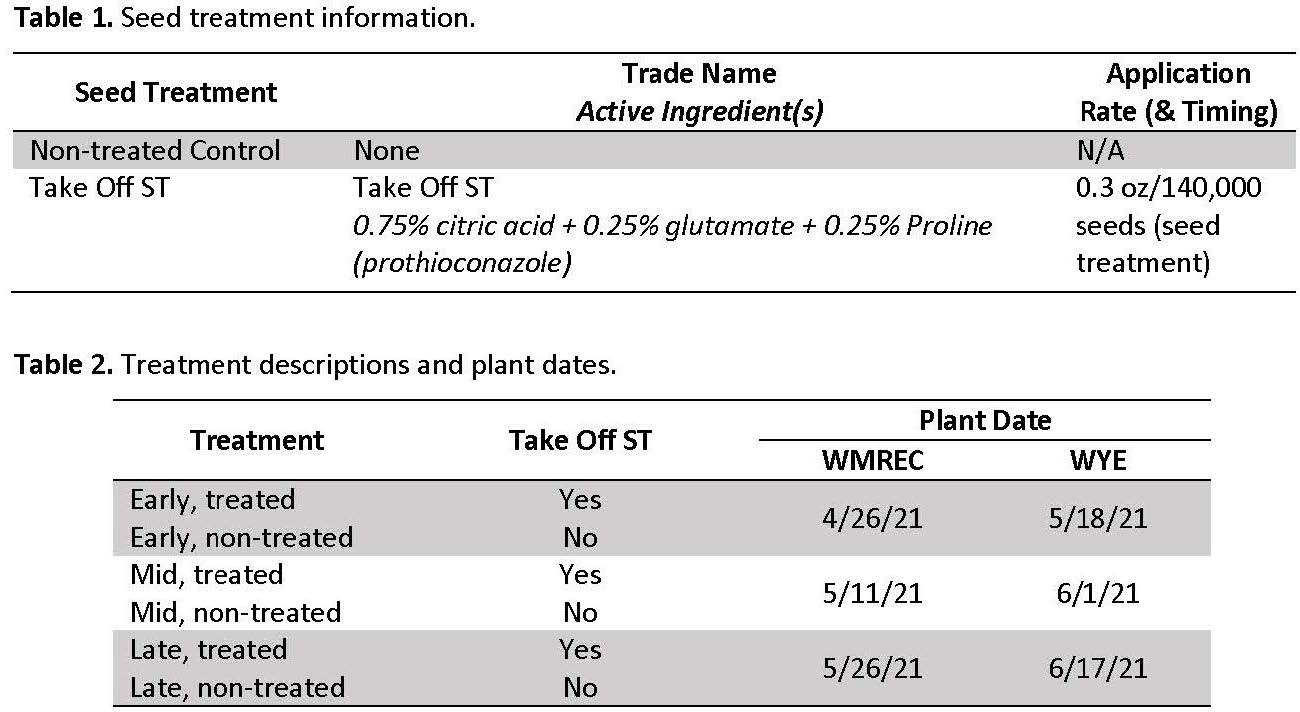
Project supported by the Maryland Soybean Board and Verdesian Life Sciences
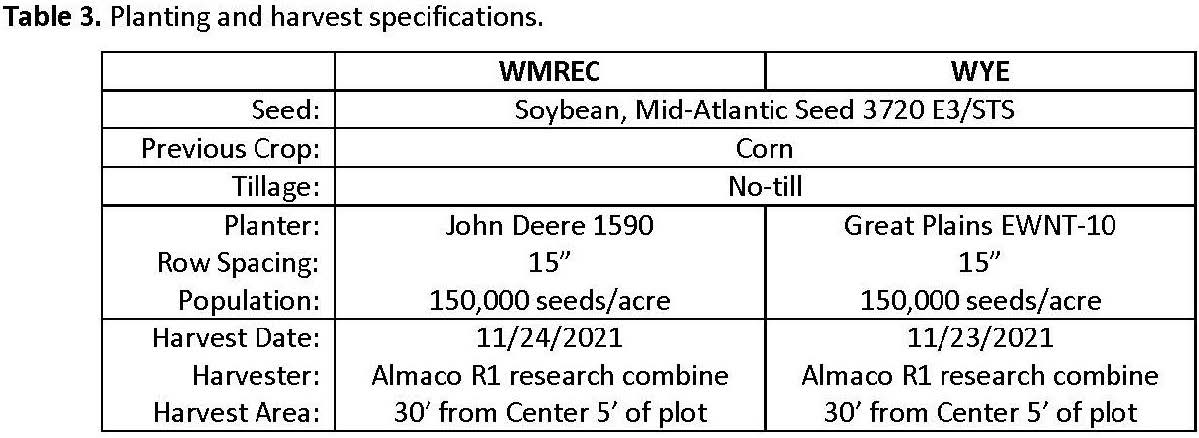
Emergence
Emergence ratings were conducted at each location approximately two weeks after planting by counting the number of emerged plants (plants at least VE growth stage) per 60 feet of plot row. Relative emergence was calculated by dividing plot emergence by the non-treated control and reported as a percentage for proper statistical comparison between treatments across locations.
Statistics
All data were analyzed in a mixed model ANOVA using JMP Pro 15 software (SAS Institute, Cary, NC). Year by location, as well as replicate, were treated as random effects in the model. Treatment effects were separated at α=0.10 and pairwise comparisons made using Fisher’s protected LSD.
RESULTS
Emergence
Take Off ST treated seed did not provide significantly greater number of emerged plants relative to the control during any planting timing at either location and suppressed germination at the early plating at the WYE location (Table 4).
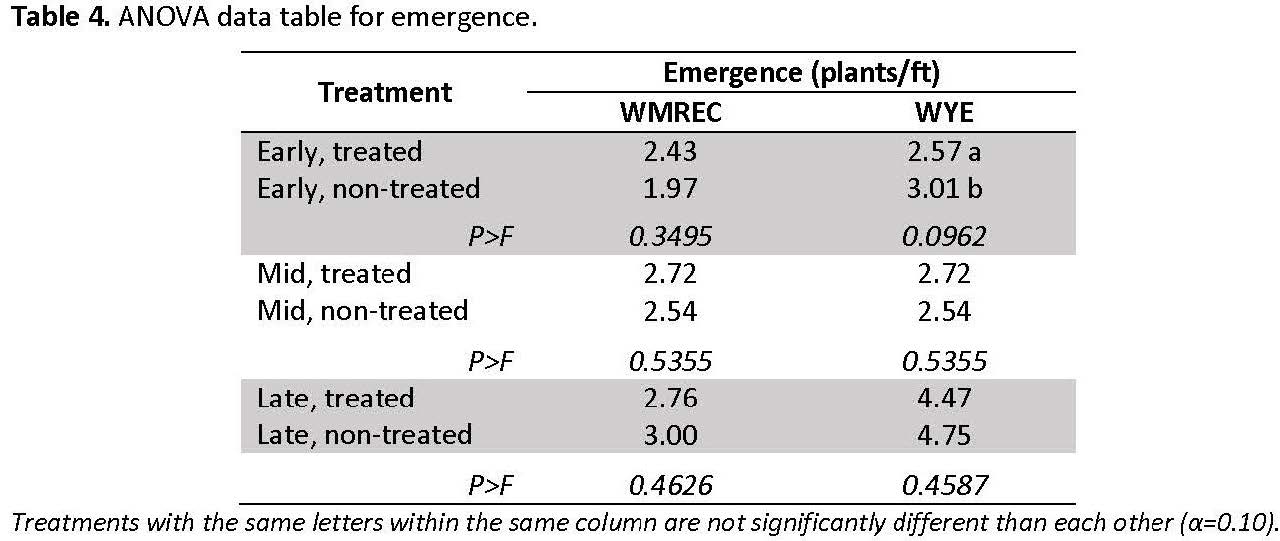

Overall, yields were higher at WMREC than WYE, with a trial average of 62.0 and 52.2 bushels per acre, respectively (Figure 1). Test weights were higher at WMREC than WYE (Table 5).
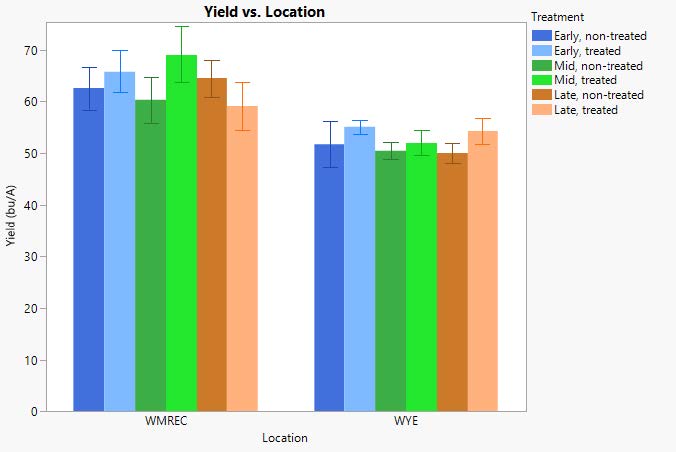
Figure 1. Treatment yield by location. Each error bar is constructed using one standard deviation from the mean. Treatments connected by the same letter are not significantly different (α=0.10).*NS= no significant differences
Comparing relative yield of the treatments as a percentage of the non-treated control is a way to statistically eliminate location as a variable in the dataset and allows for a stronger comparison due to an increased number of data points. When data for relative yield were combined for both locations, Take Off ST treated seed yielded 7.6% more than non-treated seed at early plantings (P=0.0934) and 8.6% more at middle plantings (P=0.0522, Figure 2).
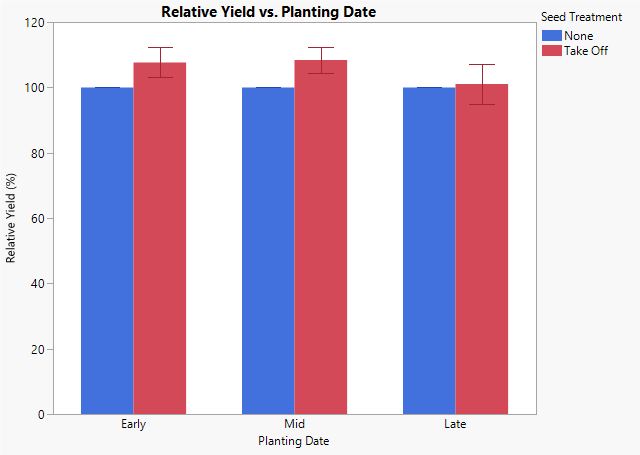
Figure 2. Relative yield vs. planting date. Each error bar is constructed using one standard deviation from the mean. Treatments connected by the same letter are not significantly different (α=0.10).*NS= no significant differences.
CONCLUSIONS, IMPLICATIONS, AND FUTURE WORK
Emergence
Take Off ST did not provide improved emergence in the 2021 trials and actually suppressed germination at the WYE middle plating location. However, it should be noted that the planting dates for the WYE location were later than those at WMREC, which could have contributed to this observation. In the previous two years of study, emergence of early planted soybeans was increased with Take Off ST. Even when relative emergence data was calculated and combined across locations there were no significant differences (data not shown, P>0.10). This is in contrast to what we observed in 2019 and 2020, where our trials that were planted earlier in the year had significantly better emergence with Take Off ST. This may be explained by weather conditions; 2019 and 2020 was cooler and wetter at our early planted locations, especially during the month of April compared to 2021 where we experienced excellent planting conditions at both locations. Data from these three years suggest that Take Off ST may help soybeans emerge in soils that are cooler and wetter, but may have little benefit for later planted soybeans. This effect may be attributed to the prothioconazole, a fungicide seed treatment that prevents preemergence damping off caused by many soilborne pathogens that are common in cool, wet soils.
Grain Yield
Yields were slightly above average at WMREC and slightly below average at WYE; this difference is likely explained by planting dates. The WMREC plots were seeded approximately one month earlier than the WYE plots.
Individual plot yields varied more at WMREC than at WYE, which could be explained by significant groundhog pressure at WMREC. As a result, extreme outliers in the dataset for WMREC were excluded in the data analysis. The only statistically significant difference in yield was observed at WMREC, where Take Off ST treated seed yielded significantly more than the non-treated seed for the middle planting date. All other pairwise comparisons within planting date × location were the same.
In order to eliminate location as a variable in our combined data analysis, relative yield was calculated. When treated seed was compared to non-treated seed in this fashion, Take Off ST treated seed yielded significantly better than non-treated seed for early and middle plantings. These data coincide with our previous observations of improved plant emergence at earlier planting dates.
None the treatments affected grain moisture or test weight.
Future research should be focused on repeating these trials to understand the effect of Take Off ST on soybeans planted at different planting dates in comparison to non-treated seed.
ACKNOWLEDGEMENTS
This work is supported by grant funding through the Maryland Soybean Board and in-kind support through Verdesian Life Sciences. Special thanks to the Maryland Agriculture Experiment Station and research farm crew at the Western Maryland Research & Education Center and the Wye Research and Education Center for making this research possible.